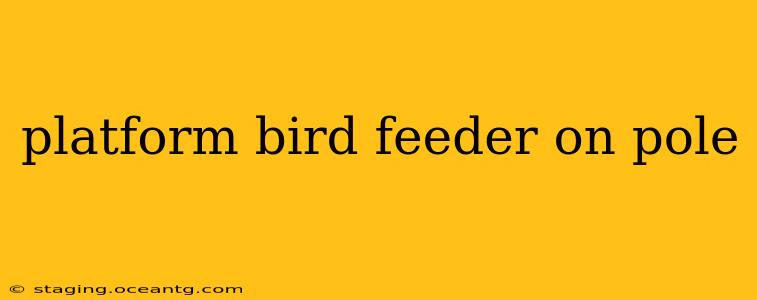Attracting a vibrant array of feathered friends to your backyard is a rewarding experience. A platform bird feeder on a pole offers a fantastic solution, providing ample space for various bird species to feed comfortably and safely. This guide will explore the benefits, installation, maintenance, and considerations for choosing the perfect platform feeder for your backyard oasis.
Why Choose a Platform Bird Feeder on a Pole?
Platform feeders, unlike tube or hopper feeders, offer an open feeding surface. This design is particularly beneficial for birds that prefer to feed on the ground or lack the dexterity to manage hanging feeders. Mounting the platform feeder on a pole elevates it, offering several key advantages:
- Predator Protection: Raising the feeder above ground significantly reduces the risk of predation from cats, raccoons, and other ground-dwelling animals.
- Improved Accessibility: A pole-mounted feeder is easily accessible for filling and cleaning.
- Enhanced Visibility: You can enjoy observing your feathered visitors from a distance without disturbing their feeding habits.
- Suitable for Diverse Bird Species: Larger birds like doves, jays, and even some waterfowl can comfortably feed from a platform, unlike smaller-opening feeders.
What are the Different Types of Platform Bird Feeders?
The market offers a variety of platform feeders, each with unique features:
- Simple Wooden Platforms: These are often the most economical option, offering a rustic charm. However, they may require more frequent cleaning and maintenance.
- Metal Platform Feeders: Durable and weather-resistant, metal feeders are a long-lasting investment. They’re often easier to clean.
- Plastic Platform Feeders: Lightweight and easy to clean, plastic feeders are a budget-friendly alternative. However, they can degrade over time, especially under intense sunlight.
- Covered Platform Feeders: These offer additional protection from rain and snow, keeping the seed dry and preventing spoilage.
How to Install a Platform Bird Feeder on a Pole?
Installing your platform feeder is straightforward, but careful planning ensures longevity and effectiveness.
- Choose a suitable location: Select a spot away from trees and shrubs, minimizing the chances of predators ambushing birds. Ensure the area provides ample visibility for you to enjoy birdwatching.
- Select the right pole: Use a sturdy pole, at least 6-8 feet tall, to elevate the feeder adequately. Consider using a metal pole for better durability.
- Secure the feeder to the pole: Ensure the platform is firmly attached using weather-resistant hardware. You might need a bracket or mount designed specifically for your feeder and pole type.
- Consider a baffle: Adding a baffle (a metal or plastic cone) below the feeder will deter squirrels and other climbing animals.
What type of pole should I use for my platform bird feeder?
The ideal pole is sturdy, weather-resistant, and tall enough to keep predators away. Metal poles are generally preferred for their durability and resistance to rot. The diameter of the pole should be sufficient to support the weight of the feeder and its contents. Consider using a pole with a pointed end to facilitate easy insertion into the ground.
How high should I mount my platform bird feeder?
The optimal height depends on your location and the potential predators. Aim for at least 6 feet, but higher might be necessary in areas with numerous ground predators. Ensure the height is manageable for you to refill and clean the feeder.
How do I prevent squirrels from getting to my platform feeder?
Squirrels are notorious for raiding bird feeders. Use a baffle to deter them. Consider a squirrel-resistant feeder design, or use smaller seed types that squirrels find less appealing. You can also explore commercially available squirrel-deterrent products.
Maintaining Your Platform Bird Feeder
Regular maintenance is crucial for keeping your feeder clean and preventing the spread of disease among birds.
- Clean regularly: Clean the feeder at least once a week, or more often during warmer months, to remove old seed, droppings, and potential disease vectors. Use warm soapy water and rinse thoroughly.
- Inspect for damage: Regularly check the feeder and pole for any damage and repair or replace as needed.
- Replace seed regularly: Keep the feeder filled with fresh seed, as spoiled seed can attract pests and mold.
By following these guidelines, you can enjoy the beauty and wonder of birds visiting your platform feeder on a pole for years to come. Remember, responsible bird feeding involves providing a clean and safe environment for your feathered friends.
